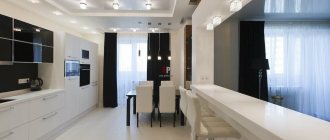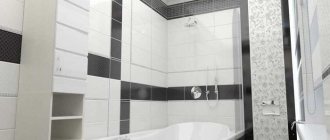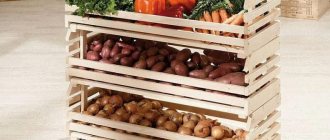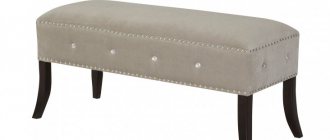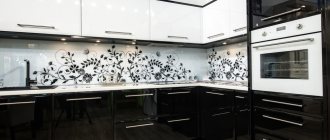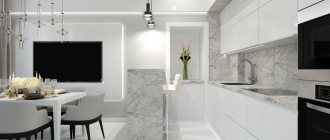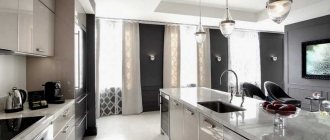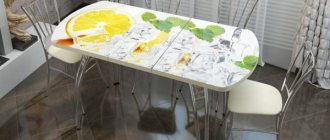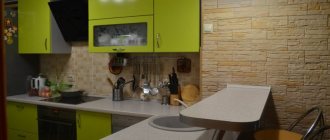Moisture resistance
The most important quality of a flooring material is its resistance to moisture. Cooking involves constant work with liquids, which means contact of the floor with water is inevitable. Kitchen floors are the most frequently cleaned floors in the house.
Light floor in the kitchen
An ideal covering option for a small kitchen. A light floor will make the room more spacious and partially solve the problem of low lighting.
On a beige floor, stains will be less visible than on a white floor. And ceramic tiles with ornaments will make minor stains completely invisible.
Where to begin?
The choice of flooring must be made at the final stage of preparing the room for renovation work.
To begin with, it is worth assessing the condition and material of the original coating, its compatibility with the selected floors in the kitchen.
At this stage, it is worth leveling the floor, insulating it, and deciding whether it is necessary to install a heated floor. It is better to ask questions about the compatibility of materials and the choice of type of floor heating to a real professional, because even a small mistake at the initial stage can be very expensive in the end.
As a next step, you should finally decide what style the kitchen will be in, and it is better to have a photo of a completed design project on hand, where the floor covering in the kitchen can be clearly seen.
The final choice of material and its color will depend on the style of the kitchen and its main color.
Tree
The most expensive material that looks very elegant and rich on the floor. Wooden floors are perfect for classic-style kitchens. You should be careful about moisture getting on such floors and try to remove the water immediately. When purchasing, you must make sure that the wood has been treated with a special moisture-repellent liquid.
Due to the high porosity of the raw material, such floors absorb liquids, which means it will be almost impossible to remove old stains from grape juice or melted chocolate. A floor made of dark types of wood will simplify this problem, but will not solve it completely.
In addition to the high price of the material itself, the work of a laying specialist is quite expensive. You should not save on it - the stingy pays twice.
Ceramics
If the kitchen is equipped with heated floors, then ceramic tiles on the floor would be an excellent option. The tile is very moisture resistant and not susceptible to dirt; it is easy to clean. The tiles do not fade when exposed to ultraviolet rays, so they are perfect for sunny rooms.
In addition to the advantages, there are also disadvantages - the tiles have low impact resistance and can crack if a heavy object falls on it.
Italian cuisines Venetto Classico- Kitchen sets Nolte Kuchen - several reasons to become the owner of such a set
Stylish decoration of kitchen walls
Floor tiles look great if the kitchen apron is also made of ceramics. It is possible to use the same tiles for these surfaces. Kitchen floor tile designs can be chosen from a wide range of patterns and designs.
You can choose ceramic tiles for absolutely any budget.
Kitchen with white floor
White flooring has its pros and cons. On the one hand, white color expands the room, always looks stylish and modern, it is easy to choose furniture and bright accessories for it, on the other hand, it is the most easily soiled finishing option. Everything from a pet's hair to a drop of sauce will be noticeable at the first glance.
White kitchen
The white floor goes well with bright finishing elements in lemon, green, dark blue, and purple tones.
Most often, white flooring is used when decorating a kitchen interior in a minimalist or high-tech style.
Linoleum
The most practical and budgetary of all materials. Linoleum does not deteriorate from exposure to water and is easily washed off from stains and dirt. Resistant to both chemical and physical influences, except cuts.
On the construction market you can find linoleum in almost any color. It can imitate not only parquet, but also tiles and even lawn. Linoleum does not at all limit the creative flight of the kitchen floor design creator.
The following materials practically copy natural ones, have a lower price and try to solve some of the shortcomings of their analogues.
Laminate
If wood is attractive, but a person does not have the appropriate budget, then laminate would be an excellent option.
- How to choose a kitchen: about ordering furniture from the manufacturer
Choosing mosaic tiles for the kitchen or bathroom. What to pay attention to.
Main nuances when choosing tiles for the kitchen
It has all the disadvantages of wood - it also does not combine well with moisture and requires constant attention from the owner. Laminate can withstand physical impacts such as scratches and impacts.
Black floor in the kitchen
A black floor is ideal for a kitchen in a minimalist or high-tech style. It goes well with white or milky cream furniture. However, bright colors in such an interior will be unnecessary.
Liquid linoleum
The self-leveling floor in the kitchen imitates a roll floor and has a number of advantages. It will withstand any mechanical damage, including scratches and cuts. It has no seams, which begin to curl up after a few years and spoil the appearance of the interior.
Don’t forget about the combination of different coatings in the interior. Using different kitchen coverings it is easy to zone the room according to use and functionality. For example, you can use durable ceramic tiles or porcelain tiles in the cooking area, and tactile wood in the dining area.
It is not easy to answer the question of which floor is best for the kitchen. The answer depends on many aspects and the personality of the owner.
- How to choose a beautiful and functional kitchen
- Kitchen knives: professional recommendations for choosing the best models
Rules for choosing colors for the kitchen
Laminate flooring for the kitchen
Very cheap and practical. Almost every second owner who renovates their kitchen chooses laminate. Why? There is a combination of interesting designs, practicality and functionality. It is difficult to damage or stain. The material is very practical and high quality.
Laminate is not durable, although it is designed to perform the basic functions of protecting the floor. It is easy to stain it if you drop a can of tomato juice or spill oil or juice.
Among the advantages are a favorable price, a large selection of patterns and tones to suit any interior.
